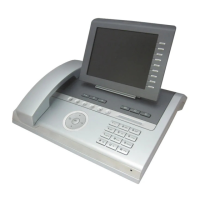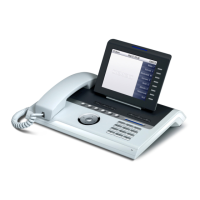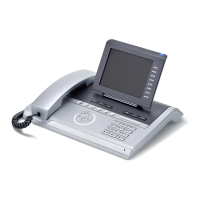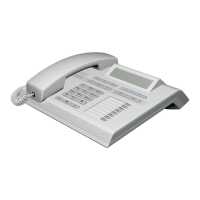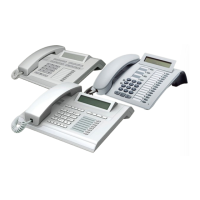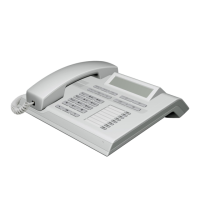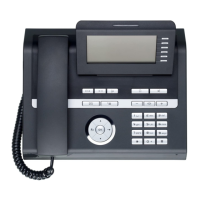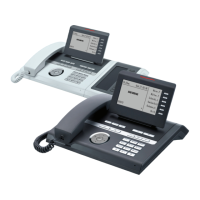Do you have a question about the Siemens OpenStage 60 and is the answer not in the manual?
Legal notice regarding product trademarks and compliance.
Guidelines for safe operation, power supply, and accessory use.
Environmental guidelines, software updates, and online support information.
Explains the guide's purpose and how to obtain service and support.
Describes UI elements, keys, TouchGuide, keypad, and mode keys for operation.
Covers phone ports, features, network connectivity, and OpenStage Manager software.
Explains graphic display, context menus, display keyboard, and text input methods.
Explains the phone's idle state, idle menu options, and message icon interpretation.
Describes display prompts for call states and message notifications.
Explains pop-up windows for prompts and context menus for options.
Explains how to use tabs and icons to select content within applications.
How to switch between applications and scroll through lists using mode keys and TouchGuide.
Explains information shown in the interface and icons for call states.
Covers accessing directories, understanding icons, and searching for contacts.
Guides on adding, editing, and using contact details for calls.
How to search LDAP and use the system's central speed-dial directory for calls.
How to view, manage, and understand details of missed, received, and dialed calls.
Explains how messages and voicemail alerts are displayed and accessed.
Guides on how to navigate the Service Menu and Telephone User Menu.
How to adjust audio, configure call forwarding, and manage Bluetooth.
Covers password protection, network status, XML apps, and the help function.
Explains how service personnel can control and monitor the phone remotely.
Step-by-step guides for answering calls using the handset or speakerphone.
Procedures for answering calls using speakerphone or headset.
How to end calls and switch between handset and speakerphone.
Instructions for making calls via different dialing methods.
How to dial while the handset is on-hook or connected via headset.
Procedures for ending a call or rejecting an incoming call.
How to temporarily mute the microphone during a call for privacy.
How to add a second party for consultation or start a conference call.
Step-by-step guide on how to transfer a call to another colleague.
How to request a callback and how to accept one when it arrives.
How to view stored callbacks and delete individual or all entries.
Procedures for answering calls using a headset or for another extension.
How to use the speakerphone and manage handsfree answerback settings.
How to speak with visitors and open doors via the phone.
How to control the door opener and handle answering machine calls.
How to redial numbers from call lists and call contacts from the personal phonebook.
How to access and use system phonebook and LDAP directory for making calls.
How to make calls using system speed-dial numbers and programmable speed dial keys.
How to make loudspeaker announcements and use discreet calling with colleagues.
How to configure automatic connections and reserve trunks.
How to assign numbers for external calls and use dialing aids.
How to handle a second incoming call during an active call.
How to manage second call signaling and camp-on tone.
How to park calls and pick them up from another phone.
How to put external calls on hold and retrieve them.
Steps to start conferences, add, and remove participants.
How to transmit DTMF signals for controlling external systems.
How to record ongoing calls and stop the recording process.
How to transfer a call after announcing it to a group.
How to send trunk flash signals for ISDN service activation.
What to do when a line is busy and how to use busy override.
How to activate, deactivate, and set up night answer services.
Methods to forward calls and identify when forwarding is active.
Lists forwarding types (All, External, Internal) and how to use the forwarding key.
How to input and copy destination numbers for call forwarding.
How to save favorite numbers for quicker call forwarding setup.
How to activate forwarding quickly and configure it via the system menu.
How to turn off call forwarding using a key or the idle menu.
How to set up and disable call forwarding when calls are not answered.
How to set up and disable call forwarding in case of telephone failure.
How to forward calls using subscriber numbers in the carrier network.
Step-by-step guide to programming function keys with various features.
Lists available functions and explains the meaning of LED indicators.
How to save sequences of operations on a single key for complex functions.
How to program internal and external numbers on the second level of sensor keys.
How to modify the text labels displayed for programmed keys.
How to remove programmed functions or entries from sensor keys.
How to add new contacts and set a default number for phonebook dialing.
How to assign a picture to a contact entry in the phonebook.
How to edit existing contact information like names and numbers.
How to set display order for contacts and delete entries or the entire phonebook.
How to create contact groups and add or remove contacts.
How to search for and import contacts from an LDAP directory into the phonebook.
How to use quick search with initial letters and wildcards in LDAP.
How to view details for call list entries and delete them.
How to copy call log entries into the personal phonebook.
How to view call charges for the current call and accumulated totals.
How to display and print call charge information for other phones.
How to assign external calls to projects using account codes.
Explains voice encryption, warnings, and visual indicators for connection status.
How to set, change, or delete the user password for phone access and security.
How to activate/deactivate the ringer cutoff and control the ring tone.
How to use DND and suppress caller ID display.
How to use the phone to listen to audio in another room.
How to record the number of malicious external callers.
How to prevent unauthorized use by locking and unlocking the phone.
How to lock or unlock other phones from your own device.
How to set or change the PIN for phone security and access.
How to program timed reminders for appointments.
How to send text messages and view/delete sent messages.
How to view and manage incoming text messages, including calling the sender.
How to leave messages for internal callers when you are absent and delete them.
How to view waiting calls and allow others to use your phone.
How to configure and use a mobile connection, and overview of mobility variants.
Steps to log your mobile connection onto a guest telephone.
How to transfer your connection and log off from the guest telephone.
How to deactivate fax signals and reset phone services to default.
How to activate various functions on other phones using specific codes.
How to access system functions remotely from an external phone using DISA.
How to use ISDN functions via codes and keypad dialing.
How to control connected computers or programs from your phone.
How to interact with PC applications using the CSTA interface for data exchange.
How to control relays for devices and utilize sensor functions on specific models.
How to locate people via pocket receivers and answer pages.
Explains different types of telephone lines and their configurations.
How line seizure is configured and sensor keys function as trunk keys.
Explains the meaning of LED indicators on trunk keys for call status.
How to answer incoming calls and dial using trunk keys.
How to put calls on hold and retrieve them using trunk keys.
How to switch between multiple calls and use MULAP conference release.
How DSS keys are configured, their LED meanings, and how to use them for calls.
How to transfer calls and answer calls for other team members.
How to forward calls on trunks using various methods and codes.
How to turn off trunk call forwarding and understand the LED indicators.
How to set up audible signaling for calls directed to an executive's phone.
How to join or leave hunt groups and group calls.
How to activate or deactivate audible tones for groups and trunks.
How to answer calls for team members and manage ringing groups.
How to log on and off as an agent for Uniform Call Distribution.
How to manage work time, night service, and view waiting calls in UCD.
How to leave or join groups using the DISA intern function.
How to activate or deactivate call forwarding from other phones using DISA.
How to set up night answer services on other phones using DISA intern.
How to save, display, and delete phones assigned to ringing groups.
How to control relays for devices and utilize sensor functions on specific models.
How to open a door using the DISA intern function.
How to adjust the display angle and activate the screensaver.
How to set the inactivity delay before the screensaver activates.
How to adjust the speed at which screensaver images change.
How to choose and apply different visual themes for the menu display.
How to adjust the brightness of the TouchSlider for better visibility.
How to adjust the sensitivity for operating the TouchGuide control.
How to adjust the key label contrast for ambient lighting conditions.
How to preset volumes for loudspeaker, ringer, handset, headset, and handsfree.
How to set acoustic profiles like Normal, Echoing, or Muffled for optimal sound.
How to configure the phone for wired or wireless DECT headset usage.
How to choose ringtones from available files or upload custom ones.
How to control the ringer and adjust call volume during a conversation.
How to configure en-bloc dialing and select the system language.
How to enable or disable Bluetooth and configure basic settings.
How to make the phone discoverable, set its name, and link devices.
How to set a PIN and manage connections with Bluetooth devices.
How to manage paired devices, create a blacklist, and scan for devices.
How to open and delete entries from Bluetooth device lists.
How to change the names of Bluetooth devices and delete them from lists.
How to enable/disable pop-up menus indicating unsecured voice connections.
How to set context menus to close automatically and define their display time.
How to define how long context menus remain open on the display.
How to view network details and access the web interface via IP address.
How to reset various user-specific settings to default factory values.
How to run a device test to check LEDs, display, and ringtone functionality.
Introduction to Bluetooth and how to manage device discoverability.
How to transfer contacts in vCard format from other devices to the phonebook.
How to send phonebook entries as vCards to other Bluetooth devices.
Steps to connect, prepare, and test a Bluetooth headset with the OpenStage phone.
How to save and restore phone settings and contacts to a USB memory stick.
Instructions for connecting a USB memory stick to the phone.
How to create a new backup or replace an existing one with a name and password.
How to select and restore data from a USB memory stick, including all data.
How to restore specific data types like phonebook or call logs from a backup.
How to check stored backups and delete them from the USB stick.
Compares display texts for functions between HiPath 2000/3000/OpenOffice and HiPath 4000 systems.
Describes the purpose of User Pages and Administrator Pages in the web interface.
How to access the web interface and use its buttons for configuration.
Lists available web interface settings with page references for descriptions.
Explains possible causes and reactions for common error messages displayed on the screen.
Addresses common problems and when to contact service personnel for persistent faults.
Guides on resolving phone issues and proper cleaning/maintenance instructions.
Legal notice regarding product trademarks and compliance.
Guidelines for safe operation, power supply, and accessory use.
Environmental guidelines, software updates, and online support information.
Explains the guide's purpose and how to obtain service and support.
Describes UI elements, keys, TouchGuide, keypad, and mode keys for operation.
Covers phone ports, features, network connectivity, and OpenStage Manager software.
Explains graphic display, context menus, display keyboard, and text input methods.
Explains the phone's idle state, idle menu options, and message icon interpretation.
Describes display prompts for call states and message notifications.
Explains pop-up windows for prompts and context menus for options.
Explains how to use tabs and icons to select content within applications.
How to switch between applications and scroll through lists using mode keys and TouchGuide.
Explains information shown in the interface and icons for call states.
Covers accessing directories, understanding icons, and searching for contacts.
Guides on adding, editing, and using contact details for calls.
How to search LDAP and use the system's central speed-dial directory for calls.
How to view, manage, and understand details of missed, received, and dialed calls.
Explains how messages and voicemail alerts are displayed and accessed.
Guides on how to navigate the Service Menu and Telephone User Menu.
How to adjust audio, configure call forwarding, and manage Bluetooth.
Covers password protection, network status, XML apps, and the help function.
Explains how service personnel can control and monitor the phone remotely.
Step-by-step guides for answering calls using the handset or speakerphone.
Procedures for answering calls using speakerphone or headset.
How to end calls and switch between handset and speakerphone.
Instructions for making calls via different dialing methods.
How to dial while the handset is on-hook or connected via headset.
Procedures for ending a call or rejecting an incoming call.
How to temporarily mute the microphone during a call for privacy.
How to add a second party for consultation or start a conference call.
Step-by-step guide on how to transfer a call to another colleague.
How to request a callback and how to accept one when it arrives.
How to view stored callbacks and delete individual or all entries.
Procedures for answering calls using a headset or for another extension.
How to use the speakerphone and manage handsfree answerback settings.
How to speak with visitors and open doors via the phone.
How to control the door opener and handle answering machine calls.
How to redial numbers from call lists and call contacts from the personal phonebook.
How to access and use system phonebook and LDAP directory for making calls.
How to make calls using system speed-dial numbers and programmable speed dial keys.
How to make loudspeaker announcements and use discreet calling with colleagues.
How to configure automatic connections and reserve trunks.
How to assign numbers for external calls and use dialing aids.
How to handle a second incoming call during an active call.
How to manage second call signaling and camp-on tone.
How to park calls and pick them up from another phone.
How to put external calls on hold and retrieve them.
Steps to start conferences, add, and remove participants.
How to transmit DTMF signals for controlling external systems.
How to record ongoing calls and stop the recording process.
How to transfer a call after announcing it to a group.
How to send trunk flash signals for ISDN service activation.
What to do when a line is busy and how to use busy override.
How to activate, deactivate, and set up night answer services.
Methods to forward calls and identify when forwarding is active.
Lists forwarding types (All, External, Internal) and how to use the forwarding key.
How to input and copy destination numbers for call forwarding.
How to save favorite numbers for quicker call forwarding setup.
How to activate forwarding quickly and configure it via the system menu.
How to turn off call forwarding using a key or the idle menu.
How to set up and disable call forwarding when calls are not answered.
How to set up and disable call forwarding in case of telephone failure.
How to forward calls using subscriber numbers in the carrier network.
Step-by-step guide to programming function keys with various features.
Lists available functions and explains the meaning of LED indicators.
How to save sequences of operations on a single key for complex functions.
How to program internal and external numbers on the second level of sensor keys.
How to modify the text labels displayed for programmed keys.
How to remove programmed functions or entries from sensor keys.
How to add new contacts and set a default number for phonebook dialing.
How to assign a picture to a contact entry in the phonebook.
How to edit existing contact information like names and numbers.
How to set display order for contacts and delete entries or the entire phonebook.
How to create contact groups and add or remove contacts.
How to search for and import contacts from an LDAP directory into the phonebook.
How to use quick search with initial letters and wildcards in LDAP.
How to view details for call list entries and delete them.
How to copy call log entries into the personal phonebook.
How to view call charges for the current call and accumulated totals.
How to display and print call charge information for other phones.
How to assign external calls to projects using account codes.
Explains voice encryption, warnings, and visual indicators for connection status.
How to set, change, or delete the user password for phone access and security.
How to activate/deactivate the ringer cutoff and control the ring tone.
How to use DND and suppress caller ID display.
How to use the phone to listen to audio in another room.
How to record the number of malicious external callers.
How to prevent unauthorized use by locking and unlocking the phone.
How to lock or unlock other phones from your own device.
How to set or change the PIN for phone security and access.
How to program timed reminders for appointments.
How to send text messages and view/delete sent messages.
How to view and manage incoming text messages, including calling the sender.
How to leave messages for internal callers when you are absent and delete them.
How to view waiting calls and allow others to use your phone.
How to configure and use a mobile connection, and overview of mobility variants.
Steps to log your mobile connection onto a guest telephone.
How to transfer your connection and log off from the guest telephone.
How to deactivate fax signals and reset phone services to default.
How to activate various functions on other phones using specific codes.
How to access system functions remotely from an external phone using DISA.
How to use ISDN functions via codes and keypad dialing.
How to control connected computers or programs from your phone.
How to interact with PC applications using the CSTA interface for data exchange.
How to control relays for devices and utilize sensor functions on specific models.
How to locate people via pocket receivers and answer pages.
Explains different types of telephone lines and their configurations.
How line seizure is configured and sensor keys function as trunk keys.
Explains the meaning of LED indicators on trunk keys for call status.
How to answer incoming calls and dial using trunk keys.
How to put calls on hold and retrieve them using trunk keys.
How to switch between multiple calls and use MULAP conference release.
How DSS keys are configured, their LED meanings, and how to use them for calls.
How to transfer calls and answer calls for other team members.
How to forward calls on trunks using various methods and codes.
How to turn off trunk call forwarding and understand the LED indicators.
How to set up audible signaling for calls directed to an executive's phone.
How to join or leave hunt groups and group calls.
How to activate or deactivate audible tones for groups and trunks.
How to answer calls for team members and manage ringing groups.
How to log on and off as an agent for Uniform Call Distribution.
How to manage work time, night service, and view waiting calls in UCD.
How to leave or join groups using the DISA intern function.
How to activate or deactivate call forwarding from other phones using DISA.
How to set up night answer services on other phones using DISA intern.
How to save, display, and delete phones assigned to ringing groups.
How to control relays for devices and utilize sensor functions on specific models.
How to open a door using the DISA intern function.
How to adjust the display angle and activate the screensaver.
How to set the inactivity delay before the screensaver activates.
How to adjust the speed at which screensaver images change.
How to choose and apply different visual themes for the menu display.
How to adjust the brightness of the TouchSlider for better visibility.
How to adjust the sensitivity for operating the TouchGuide control.
How to adjust the key label contrast for ambient lighting conditions.
How to preset volumes for loudspeaker, ringer, handset, headset, and handsfree.
How to set acoustic profiles like Normal, Echoing, or Muffled for optimal sound.
How to configure the phone for wired or wireless DECT headset usage.
How to choose ringtones from available files or upload custom ones.
How to control the ringer and adjust call volume during a conversation.
How to configure en-bloc dialing and select the system language.
How to enable or disable Bluetooth and configure basic settings.
How to make the phone discoverable, set its name, and link devices.
How to set a PIN and manage connections with Bluetooth devices.
How to manage paired devices, create a blacklist, and scan for devices.
How to open and delete entries from Bluetooth device lists.
How to change the names of Bluetooth devices and delete them from lists.
How to enable/disable pop-up menus indicating unsecured voice connections.
How to set context menus to close automatically and define their display time.
How to define how long context menus remain open on the display.
How to view network details and access the web interface via IP address.
How to reset various user-specific settings to default factory values.
How to run a device test to check LEDs, display, and ringtone functionality.
Introduction to Bluetooth and how to manage device discoverability.
How to transfer contacts in vCard format from other devices to the phonebook.
How to send phonebook entries as vCards to other Bluetooth devices.
Steps to connect, prepare, and test a Bluetooth headset with the OpenStage phone.
How to save and restore phone settings and contacts to a USB memory stick.
Instructions for connecting a USB memory stick to the phone.
How to create a new backup or replace an existing one with a name and password.
How to select and restore data from a USB memory stick, including all data.
How to restore specific data types like phonebook or call logs from a backup.
How to check stored backups and delete them from the USB stick.
Compares display texts for functions between HiPath 2000/3000/OpenOffice and HiPath 4000 systems.
Describes the purpose of User Pages and Administrator Pages in the web interface.
How to access the web interface and use its buttons for configuration.
Lists available web interface settings with page references for descriptions.
Explains possible causes and reactions for common error messages displayed on the screen.
Addresses common problems and when to contact service personnel for persistent faults.
Guides on resolving phone issues and proper cleaning/maintenance instructions.
| Type | IP Phone |
|---|---|
| Lines | 6 |
| Wall Mountable | Yes |
| Protocols | SIP |
| Ethernet Ports | 2 |
| Audio | Full-duplex speakerphone |
| Keys | 8 programmable keys |
| Power | PoE |
| Headset Port | Yes |
